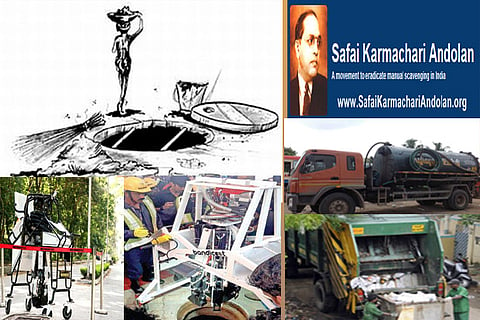

Chennai
It is in the midst of such a health emergency that Tamil Nadu has borne witness to shameful, avoidable tragedies involving manual scavengers, that have been occurring time and again. Earlier this month, four youngsters from Thoothukudi died from asphyxiation after they were contracted by a private individual to clean his septic tank. More recently, two men in Chennai also succumbed to noxious fumes after they were hired to work under similar circumstances.
The state’s track record of deaths involving manual scavengers reveals that TN leads the pack among all Indian states, in this dehumanising statistic. As per the results of a government survey conducted late last year in 170 districts across 18 states, over 206 manual scavengers in TN lost their lives while involved in cleaning of hazardous septic tanks and sewers – between 1993 and July 2019. As many as 54,130 people were part of this line of work. But it’s not the absence of a legal framework prohibiting the employment of people in such hazardous environments that allows such travesties to continue. In 1993, The Employment of Manual Scavengers and Construction of Dry Latrines (Prohibition) Act banned manual scavenging in the country. A decade later, another legislation was passed that barred the employment of individuals as manual scavengers. There are penalties ranging from a one to two-year imprisonment for those employing such services and fines of Rs 50,000 to Rs 2 lakh.
The punishment does not serve as a deterrent in a nation, where the onus of sanitation is placed upon individuals themselves with the state having zero accountability. The urban sprawl of India often prohibits entry of mechanised sanitation equipment into neighbourhoods located in slums where it is impossible to work without human intervention.
Add to this a continuing practice of discrimination – that has been passed on from generation to generation. As per data from the Safai Karmachari Andolan, an initiative aimed at ending manual scavenging in the country, more than 98 pc of those engaged in such jobs hail from Dalit communities. One must also consider the unorganised nature of work – which promotes a culture of exploitation through cheap labour. The use of hydraulic and suction based equipment for sanitation works is only gradually gaining prominence. For citizens living in rural India, a decade ago, it might not have been an uncommon sight to see a conservancy worker toss a lit matchstick into the sewer before entering it, just to check if it causes a fire. In some cases, a live chicken is lowered into the septic tank and workers wait for half an hour to see if it survives, after which they get to work.
But things are starting to look up. Earlier this month, the Rajasthan government instructed officials to ensure septic tanks or sewage chambers are cleaned using only machines. In Kerala, a start-up introduced a robot powered by an infrared camera, that can help clean and unblock manholes and septic tanks with zero human-intervention. Technology aside, there is a requirement of political will to help change the fortunes of such workers. Like how the government offers metro water and garbage disposal services, the state must consider setting up a separate vertical to address the issue of sanitation. Representatives from the health sector, local bodies and private enterprises must also be encouraged to be participants going forward. By bringing sanitation workers under an organised official umbrella, the government could consider making its services chargeable, and above all, introduce an unbreachable level of accountability.
Visit news.dtnext.in to explore our interactive epaper!
Download the DT Next app for more exciting features!
Click here for iOS
Click here for Android